Topór coat of arms
| Topór | |
|---|---|
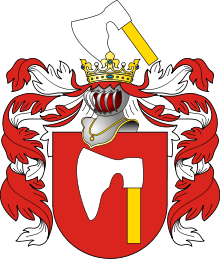 | |
| Details | |
| Battle cry | Szarża |
| Alternative names | Bipenna, Bipennis, Szarża, Wścieklica |
| Earliest mention | 1282 (seal), 1401 (record) |
| Families |
640 names Abakiewicz, Aleksandrowski, Andulski, Aszkiełowicz. Bachmiński, Balicki, Bałchacki, Baratyński, Barluniński, Bąkiewicz, Bełchacki, Bełechacki, Bendkowski, Bętkowski, Białośliwski, Białowiejski, Bielecki, Bielicki, Biesicki, Biesiecki, Biesiekierski, Biesierski, Bije, Birkowski, Biskowski, Bogdanowicz, Bogucki, Boguski, Boguskowski, Bogusz, Bokiewicz, Boksa, Boksza, Bokszański, Boniatowski, Boratyński, Borkowski, Borsuk, Broniewski, Broniowski, Bruniewski, Bruniowski, Brzeski, Brzezieński, Brzeziński, Brzozowski, Budgin, Budrewicz, Budrym, Butrym, Butrymowicz, Butrymowski, Byczkowski, Bykowski. Caliński, Charmęski, Charmieski, Chłusewicz, Chłusiewicz, Chocieszewski, Chociszewski, Chociszowski, Chroberski, Chrycewicz, Chrystowski, Chrzelowski, Cielużyński, Cierznicki, Ciesielski, Cikowski, Czaplicki, Czayański, Czelużyński, Czerśnicki, Czerżnicki, Cześnicki, Częstuniewski, Czodliński, Czyżewski, Czyżowski. Damaborski, Danaborski, Dąbrowski, Decius, Deciusz, Dimski, Długoborski, Dragatt, Drąsejko, Dronsejko, Dukielski, Dulowski, Dusejko, Dusieyko, Dycz, Dyminicz, Dymski, Dzianajewicz, Dzienajewicz, Dzierkowski, Dzierzbicki, Dzierzkowski, Dzierżbicki, Dzierżkowski, Dziewczopolski, Dziwulski. Faranowski, Farnowski, Felczyński, Fergis. Gajnowski, Garlicki, Gaufman, Giegocki, Giergielewicz, Giżelewski, Golanczewski, Gołkowski, Goryniecki, Gorzeński, Gorzkowski, Gotart, Goźlicki, Górecki, Grabowski, Gramatski, Grillewicz, Grocholski, Grochowiecki, Grodzicki, Grudziński, Grycewicz, Grylewski, Grzegorzewski, Grzegorzowski, Gutowski. Halko, Hałko, Hauffmann, Hinek, Hinko, Hoffman, Houfman, Hrycewicz, Hynek. Ibiański. Jabłoński, Jabłowski, Jachimowski, Jachnowicz, Jackiewicz, Jagintowicz, Jakubiński, Jakubowicz, Jakubowski, Jakubski, Jakutowicz, Janikowicz, Janiszewski, Jankiewicz, Jankowski, Janowski, Jaranowski, Jarantowski, Jarnowski, Jaronowski, Jaroński, Jasieński, Jasiński, Jesiński, Jewłaszewski, Jezierski, Jukubowski, Jurczycki. Kaleński, Kalinowski, Kaliński, Kamedulski, Kamieński, Kamiński, Kaniszewski, Kapliński, Kapustyński, Kardamowicz, Kempski, Kępski, Kibort, Kieński, Kiergielewicz, Kierglewicz, Kisielnicki, Kleszczowski, Klikowicz, Klimontowski, Klimuntowski, Kloński, Kluński, Kłobuczyński, Kłoński, Kłuński, Kniepowicz, Knopf, Koczarski, Koczorski, Koiszewski, Koiszowski, Kojrowicz, Kolczewski, Kolesiński, Kolęcki, Kolibski, Kolszewski, Kołczek, Konarski, Kondrat, Kopytyński, Kornacki, Kornecki, Korycieński, Koryciński, Korzenicki, Korzeniecki, Kosielski, Kownacki, Kozielski, Krakowczyk, Krasieński, Krasnopolski, Krasznicki, Kraśnica, Krężnicki, Królewiecki, Krupowicz, Krupowies, Krynicki, Krzetowski, Krzętowski, Krzucki, Krzyski, Krzywczycki, Krzywczyński, Krzywosąd, Krzywozycki, Księski, Kuliński, Kułak, Kunaszewski, Kunaszowski, Kunat, Kunato, Kunejko, Kuneyko, Kunowski, Kunszewski, Kurowski, Kurzewski. Lacza, Laskowiecki, Laskownicki, Laskowski, Lgocki, Ligęza, Lipnicki, Lowinicki, Lownicki. Łabiszyński, Łabyszcki, Łabyszczki, Łącki, Łekieński, Łękawski, Łobżenicki, Łobżeński, Łotoczek, Łotoczko, Łowieniecki, Łukowski. Maciejewski, Maciejowski, Malc, Małomiącki, Małoniecki, Małżyński, Manasterski, Manastyrski, Marcinkowski, Marcinowski, Marciszewski, Margiewicz, Martyszewski, Masłomiącki, Masłomięcki, Masłowski, Matuszewski, Matuszowski, Matyszewski, Melsztyński, Miastowski, Miedzwiecki, Miedzwiedzki, Miedzychowski, Miedźwiecki, Miedźwiedzki, Międzygórski, Milkowicz, Miniszewski, Miniszowski, Misiewicz, Missiewicz, Młodziejewski, Młodziejowski, Młodzowski, Modliszewski, Mołochowiec, Montułt, Morawicki, Morawiński, Morski, Mosiej, Mosiewicz, Moszgawski, Moszyński, Mozgawski. Narbut, Narbutt, Narutowicz, Naschian, Nasion, Nasyan, Naszyon, Nawoj, Nawoy, Nekanda, Nekanda-Trepka, Neorza, Nieborski, Niedroski, Niedrowski, Niedzielski, Niedźwiecki, Niedźwiedzki, Niekrasz, Niekraszewicz, Niekraś, Niemira, Niemirowicz, Niemiryc, Niemirycz, Niemirzyc, Nierwid, Nieznański, Norwid, Nos, Nosewicz, Nosowicz, Nossewicz. Obakiewicz, Obidziński, Obiedziński, Obodyński, Obodzieński, Obodziński, Oborzyński, Obricht, Obrycht, Obydziński, Ochabowicz, Oczechowski, Odalkowski, Odolikowski, Odolkowski, Okołow, Okołowicz, Okołów, Okulicz, Olbrich, Olbricht, Oryński, Orzechowski, Osaliński, Osoliński, Ossoliński, Ostrowicki, Ostrowidzki, Ostrowiecki, Ostrowski, Ostrzyński, Otrowski, Otta, Owca. Pacyński, Paczołtowski, Paczyński, Padlewicz, Pałuka, Panigrodzki, Patrycki, Patrzycki, Pełka, Pemperski, Pernaszewicz, Pianowski, Piekarski, Pielecki, Pierszycki, Pietkiewicz, Pijanowski, Pilcicki, Pilczycki, Pilecki, Piotrkowski, Pisarzewski, Plaga, Plagga, Plaska, Plaskowski, Pląskowski, Plechowski, Pleszewski, Pleszowski, Płajski, Płaska, Płaski, Płaskowski, Płaza, Płocki, Płotnicki, Poborski, Poburski, Połnos, Prusinowski, Przespolewski, Przybytniowski. Rabsztyński, Raczyński, Radliński, Rajterowski, Rakowiecki, Rakowski, Rapczyński, Rapsztyński, Rąbczyński, Rąmbczyński, Regulski, Repnik, Robaczyński, Rogulski, Rokowski, Rosławowicz, Rosperski, Rospierski, Roth, Rucki, Rykowski, Rykrski, Ryszkowski, Rytarowski, Ryterski, Rzancki, Rzeczkowski, Rzepliński, Rzeszowski. Safarewicz, Sarna, Sarnowski, Schaaf, Sczawiński, Sieciech, Sieciechowski, Siekierzecki, Siekierzycki, Sinicki, Skąpski, Skidziński, Skirgajło, Skorobohaty, Skrodzki, Skrzelowski, Skrzetuski, Skwarczyński, Sladowski, Sleżowski, Sławianowski, Sławiec, Sławnik, Słupowski, Słupski, Smogulecki, Smoszewski, Smoszowski, Smuszewski, Sokołowski, Solajski, Sośnicki, Sośniecki, Staręski, Starołęski, Starski, Starzeński, Starzewski, Starzon, Starzyski, Starża, Starżon, Stobiecki, Straszkiewicz, Straszkowski, Strażoń, Strzetuski, Subiński, Sulisławski, Supiński, Surgewski, Suszczewicz, Szabecki, Szalowski, Szałacki, Szałajski, Szarbski, Szarna, Szarniewski, Szczawiński, Szczerbiński, Szewczycki, Szołajski, Szotajski, Szylański, Szyłański, Szymanowski. Śladowski, Ślezanowski, Ślezański. Tarło, Tarnawiecki, Tarnowiecki, Tarnowski, Tarulewicz, Tenczyn, Tenczyński, Terlieczki, Tęczyna-Marcinkowski, Tęczyński, Tilkowski, Tochołowski, Tomiszewski, Toniszewski, Toporski, Towgin, Towginowicz, Towtko, Towtkowicz, Trambczyński, Trąbczyński, Trąmbczyński, Trąmpczyński zw (Niedźwiadek), Trąpczyński, Trelęski, Trepka, Trlęski, Trojan, Trylski, Trzciński, Tuchołowski, Tułkowicz, Tułkowiecki, Tułkowski, Tuskiewicz, Twierbutt, Twirbut, Tylkowski, Tynkhaus. Uniewski, Uzłowski. Wahl, Waldowski, Walentynowicz, Wałdowski, Wąsowski, Werbusz, Więckiewicz, Więckowicz, Wilamowski, Wilcki, Wilkowicki, Wilkowiecki, Witort, Wiziński, Włosto, Włostowski, Włościborski, Włościbowski, Wojnowski, Wolski, Wrona, Wroniewski, Wronowski, Wrzebski, Wrzępski, Wrzosowski, Wścieklica. Zabieła, Zabiełło, Zabuski, Zagorzański, Zajączkowski, Zaklicki, Zaklika, Zakliko, Zakrzewski, Zaleski, Zalęski, Zaliwaka, Zaliwako, Załuski, Zawisza, Zbyluta, Zbyszewski, Zemła, Zemło, Zęczyn, Zieniuch, Złotek, Złotkowski, Złyński, Zmorski, Zręcki, Zrzęcki, Zula, Zwierowicz, Zwierz, Zwierzański, Zwierzyński, Zwirewicz, Zwirzewicz, Zwolski. Żebrowski, Żegota, Żelski, Żołtański. |
| Cities | Opole Lubelskie, Rymanów, Stawiski, Chyrów, Toporów |
| Divisions | Gmina Klimontów, Gmina Końskowola, Gmina Zaklików (former city), Gmina Żegocina |
Topór (Polish for "axe") is a Polish coat of arms. It was used by several szlachta (noble) families in medieval Poland and under the Polish-Lithuanian Commonwealth.[1]
History
The topór coat of arms is said to be one of the oldest Polish szlachta emblems, if not the oldest. Its use dates back to at least as far as a seal of the late 13th century. Before the Union of Horodło (1413) approximately 220 Polish szlachta families - mostly in and around Kraków, Lublin and Sandomierz - used this symbol.
Under the Union the coat of arms was represented by Maciej z Wąsocza, the Voivod of Kraków, and by Jan Butrym, a Lithuanian boyar who represented Lithuanian noble families. After the union another 150 families in Lithuania adopted the topór coat of arms. Due to its antiquity it was sometimes referred to as "Starża", an Old-Polish word denoting great age.
Blazon
Gules, axe argent. The crest is in the form of an axe embedded in the helm, argent.
In Latin: (Topor). Thopor siue Bipennis alba in campo rubeo (...)[2]
Notable bearers
Notable bearers of this coat of arms have included:
- Jan Jerzy Grabowski
- Cyprian Norwid
- House of Ossoliński
- House of Tęczyński
- Zbigniew Tęczyński
- Jan Magnus Tęczyński
- House of Tarło
- Teofilia Tarło
- Zygmunt Tarło
- Jan Tarło
- Andrzej Tarło
- Pawel Tarło
- Jadwiga Tarło
- Stanisław Tarło
- Jan Karol Tarło
- Barbara Tarło
- Eustachy Trepka
- Józef Zabiełło
- Family of Zemła and Zemło ennobled 1413 in the Union of Horodło for taking part and courageous fighting in the battle of Grunwald 1410.
Gallery
Aristocratic variations
-
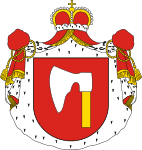
Princely House of Ossoliński (1633)
-

Counts Dzierzbicki (1824)
-

Counts Grabowski (1816)
-

Counts Morski (1781)
-

Counts Ossoliński (1785) and Counts Tęczyński (1561)
-

Counts Zabiełło (c. 1683)
-

Coat of arms of baron Wincenty Jakubowski (1808)
Standard variations
-

Ennoblement of Ludwik Justyn Deciusz (1531) (noted by J.K. Ostrowskiego)
-

Coat of arms of family Gumowski (18th century)
-

Ennoblement of Sebastian Jakubowski (1790)
-

Ennoblement of Michał, Kazimierz and Felicjan Jakubowski (1764)
-

Coat of arms of the Morawicki family (Morawitzky) (Silesia, 17th century)
-

Variation of the coat of arms of Julius Paczeński (adopted by Ferdynand von Reinersdorf) (noted by J.K. Ostrowskiego)
-

Ennoblement of Wawrzyniec z Kazimierza (1569) (wrongly ascribed by Chrząński as the coat of arms of the Tarło family)
-

Topór II – variant
-

Topór III – variant
-

Topór IV – variant
-

Topór V – variant
Coat of arms of cities and gminas
-

Coat of arms of Krajenki
-

Coat of arms of Opole Lubelskie
-

Coat of arms of Rymanowa
-

Coat of arms of Stawisk
-

Prewar coat of arms of Chyrowa
-

Prewar coat of arms of Toporów
-

Coat of arms of Gmina Klimontów (former city)
-

Coat of arms of Gmina Końskowola (former city)
-

Coat of arms of the former city of Zaklikow
-
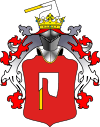
Prewar coat of arms of Gmina Żegocin
Coat of arms with the topór symbol
-
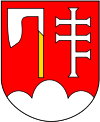
Coat of arms of Krzeszowice
-

Coat of arms of Leszno
-

Coat of arms of Wągrowiec
-
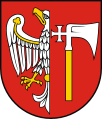
Coat of arms of Powiat Wągrowiec
-

Coat of arms of Żabno
-

Prewar coat of arms of Mosty Wielkie
-

Coat of arms of former Gmina Białołęka
-
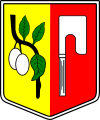
Coat of arms of Gmina Białośliwie
-

Coat of arms of Gmina Liszki
-

Coat of arms of Gmina Łańcut
-

Coat of arms of Gmina Mielec
-
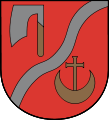
Coat of arms of Gmina Mircze
-

Coat of arms of Gmina Nawojowa
-

Coat of arms of Gmina Sterdyń
-

Coat of arms of Gmina Tarłów
-

Coat of arms of Gmina Wilczyce
-
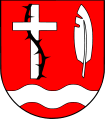
Coat of arms of Gmina Zabrodzie
-

Coat of arms of Gmina Zębowice
-

Coat of arms of Gmina Limanowa
-

Coat of arms of Gmina Nowe Brzesko
-
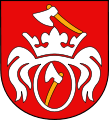
Coat of arms of Gmina Trzcinica
Paintings with the coat of arms topór
-

Portrait of Jerzy Ossoliński with coat of arms in upper left
-
.jpg)
Portrait of Franciszek Maksymilian Ossolinski with coat of arms on the shield (right bottom corner)
-

Portrait of Jan Zbigniew Ossolinski with coat of arms in upper right
-
Jan Magnus Tęczyński with coat of arms in upper right
-
Topór on the painting of Elizabeth Granowska, 1779
Other
-
The epitaph of Jan Kanty Tarło (1790-1855) in Szczaworyż, Church of St. James
-
Coat of arms of the Ossoliński family on the St. Antoni Padewski Church in Warsaw
-

The ruins of Krzyżtopór Castle in Ujazd (topór coat of arms on the right side of the gate)
See also
- Polish heraldry
- Heraldic family
- List of Polish nobility coats of arms
Bibliography
- Kasper Niesiecki: Herbarz polski. T. 9. 1839-1846
- Franciszek Piekosiński: Heraldyka polska wieków średnich. Kraków: Akademia Umiejętności, 1899
- Józef Szymański: Herbarz średniowiecznego rycerstwa polskiego. Warszawa: PWN, 1993
- Bartosz Paprocki, Jan Kazimierz Turowski: Herby rycerstwa polskiego przez Bartosza Paprockiego zebrane i wydane r. p. 1584. Kraków: Wydawnictwo Biblioteki Polskiej, 1858.
- Stanisław Teodor Chrząński: Tablice odmian herbowych. Juliusz Karol Ostrowski, 1909, s. V.
- Tadeusz Gajl: Herbarz polski od średniowiecza do XX wieku : ponad 4500 herbów szlacheckich 37 tysięcy nazwisk 55 tysięcy rodów. L&L, 2007, s. 363. ISBN 978-83-60597-10-1.
- Barbara Trelińska: Album armorum nobilium Regni Poloniae XV - XVIII saec. Herby nobilitacji i indygenatów XV - XVIII w.. Lublin: 2001,
- Stanisław Dziadulewicz: Herbarz rodzin tatarskich w Polsce. Wilno: Stanisław Dziadulewicz, 1929
References
| ||||||||




